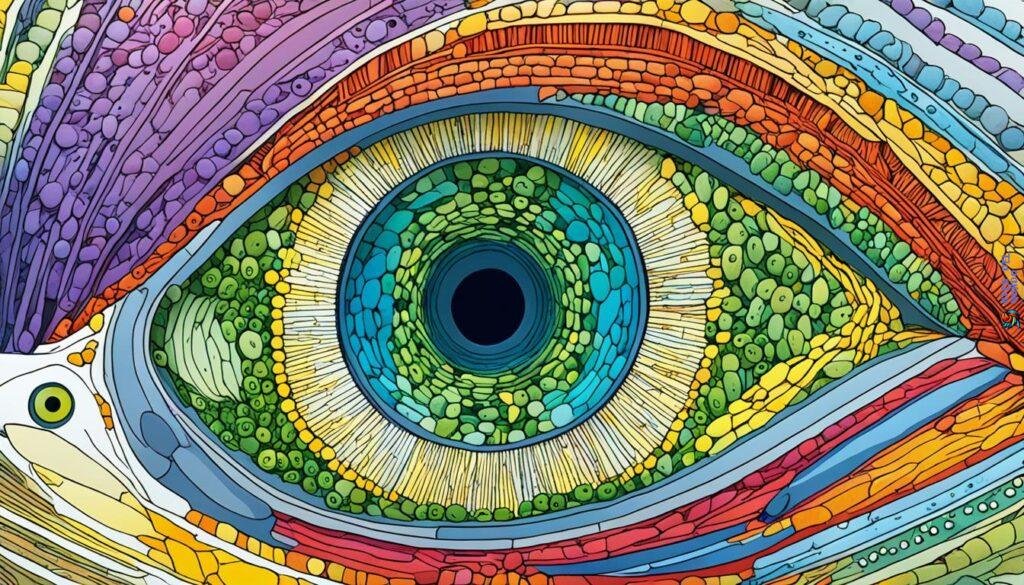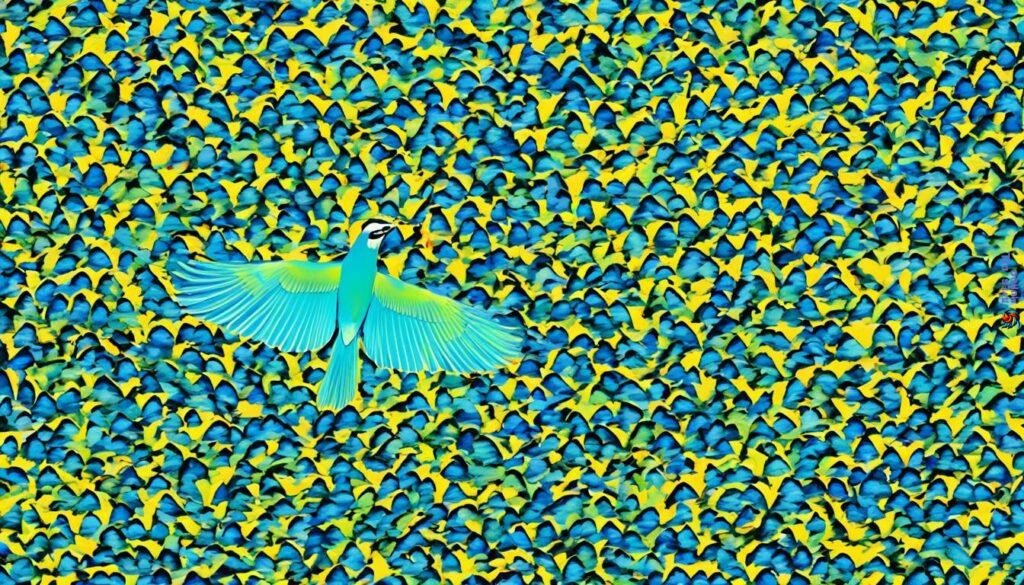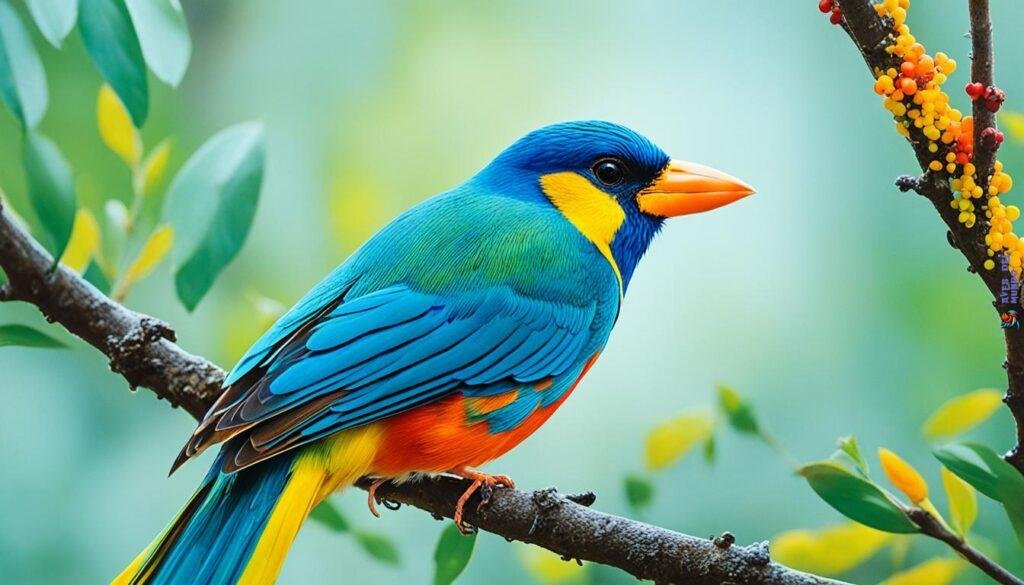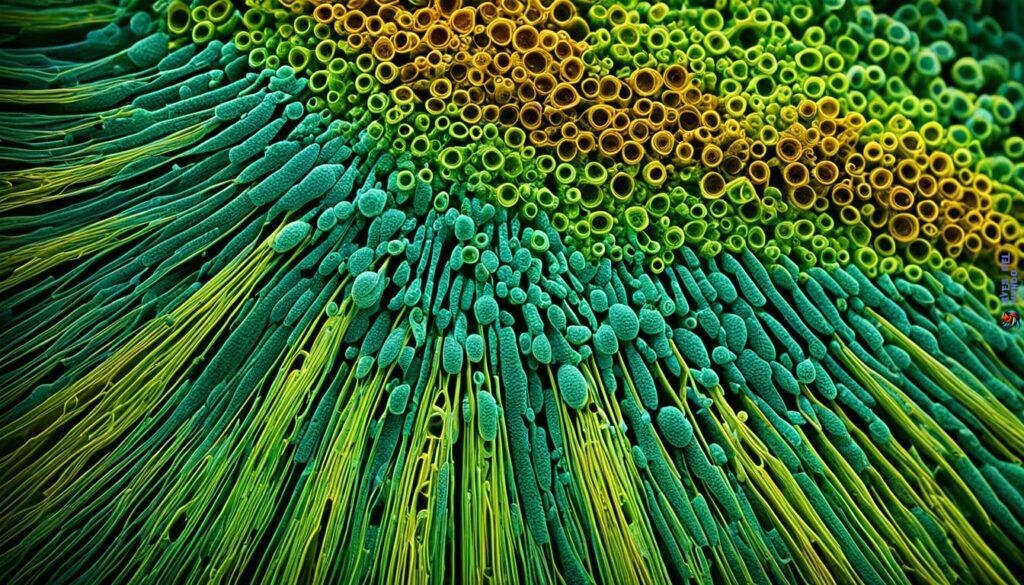Did you know that birds have a visual acuity that far surpasses our own? Their eyes are uniquely adapted to their aerial lifestyle, allowing them to see the world in stunning detail and vibrant colors. In this article, we will explore the wonders of bird vision, from their remarkable visual acuity to the intricate anatomy and adaptations of their eyes. Get ready to delve into the fascinating realm of bird vision and discover the secrets behind their extraordinary optical capabilities.
The Acuity of Avian Eyesight
One of the most remarkable aspects of bird vision is their superior visual acuity. Birds can see with remarkable clarity and detail, often far surpassing human visual capabilities. They have more photoreceptor cells in their retinas, allowing them to perceive finer details and detect subtle movements. Additionally, birds have a higher density of cones, the photoreceptor cells responsible for color vision, which contributes to their ability to see vibrant hues in their environment. This heightened acuity is essential for birds during flight, hunting, and identifying potential mates or rivals.
Photoreceptor Cells and Visual Acuity
The avian eye is equipped with a higher number of photoreceptor cells, specifically cones, than the human eye. These cones enhance birds’ ability to see fine details and distinguish between objects with greater precision. With a greater number of photoreceptor cells, birds are able to perceive subtle movements and patterns that may go unnoticed by the human eye.
Improved Color Vision
Birds also possess a higher density of cones, which enables them to have a broader range of color vision. This allows them to see vibrant and intricate colors in their surroundings, helping them locate food sources and identify suitable mates. With their enhanced color perception, birds can navigate their environments more effectively and make informed decisions based on visual cues.
Role in Flight and Hunting
The exceptional visual acuity of birds is particularly advantageous during flight and hunting. Birds need to accurately perceive their environment to avoid obstacles and predators while maneuvering through the air. Their ability to detect fine details and movements helps them locate prey, track it during pursuit, and ensure precise strikes. Furthermore, their heightened visual acuity assists in identifying potential mates and rivals, enabling effective competition for resources and successful reproduction.
| Visual Acuity in Birds | Visual Acuity in Humans |
|---|---|
| Birds can see objects with greater clarity and detail thanks to their high number of photoreceptor cells. | Human vision is limited in perceiving fine details and movements due to a lower number of photoreceptor cells. |
| Birds have a higher density of cones, which enhances their color perception. | Humans have a lower density of cones, leading to a narrower range of color vision compared to birds. |
| Their heightened visual acuity aids in flight navigation, precise hunting, and identifying potential mates and rivals. | Human visual acuity may vary and is generally adapted to terrestrial environments. |

The Anatomy of Bird Eyes
The anatomy of bird eyes is fascinating and uniquely adapted to meet the demands of their aerial lifestyle. Birds have large eyes that are proportionally larger than those of most mammals, allowing them to gather more light and enhance their visual sensitivity. This heightened sensitivity is crucial for birds to perceive their surroundings with remarkable precision and navigate through complex environments.
However, the structure of bird eyes differs from that of mammals in several ways. Unlike humans, who rely on a specialized area called the fovea for sharp central vision, birds lack a fovea in their retinas. Instead, they have a unique structure called the pecten, which serves multiple functions in supporting their visual acuity.
The pecten is a thin, comb-like structure that extends from the back of the eye towards the center. It supplies additional nutrients and oxygen to the retinas, ensuring optimal functionality even during the high-speed flight and rapid altitude changes that many bird species experience. This adaptation allows birds to maintain clear and precise vision, regardless of their aerial maneuvers or environmental conditions.
Additionally, avian retinas contain a higher density of photoreceptor cells compared to mammals, enabling birds to perceive finer details and detect subtle movements in their environment. This heightened visual acuity is essential for birds in various aspects of their lives, such as hunting for prey, avoiding obstacles during flight, or recognizing potential mates or rivals.

The intricate anatomy of bird eyes is a testament to the remarkable adaptations that have evolved to meet the unique visual demands of avian life. By understanding the anatomy and function of bird eyes, we gain a deeper appreciation for the wonders of bird vision and the amazing capabilities of these aerial creatures.
Color Perception in Birds
Birds possess a remarkable ability to perceive a wide range of colors, far beyond what the human eye can see. This enhanced color perception is due to their specialized color receptors, known as cones, which allow them to detect ultraviolet light. While invisible to us, this ultraviolet vision opens up a whole new dimension of color for birds.
Enhanced color perception serves various functions in a bird’s life. It helps them identify ripe fruits, which often display distinct color variations when ready for consumption. Nectar-rich flowers, too, reveal hidden patterns under ultraviolet light that guide birds in their search for nourishment. Additionally, vibrant plumage plays a vital role in bird communication and courtship rituals. By discerning even the subtlest color variations, birds can recognize potential mates and establish social hierarchies.
Birds’ exceptional color perception goes beyond mere aesthetics. It is a critical asset for their foraging, navigation, and social interactions. Let’s explore some fascinating examples of how birds utilize their heightened color perception:
- Foraging: Birds rely on their ability to recognize different-colored food sources. For example, some birds use color cues to determine the ripeness of fruit, helping them select the most nutritious options. By perceiving the ultraviolet patterns on flower petals, hummingbirds can locate the flowers with the highest concentrations of nectar.
- Navigation: Certain migratory birds rely on color perception to orient themselves and navigate vast distances. They use ultraviolet cues from the sky to align themselves with specific compass directions, leveraging the changing angles of sunlight. This remarkable adaptation enables them to undertake long and arduous journeys with precision.
- Social Interactions: Vibrant plumage plays a crucial role in attracting mates and establishing dominance within bird populations. Birds with more vibrant and well-maintained plumage are often seen as more desirable mates. The enhanced color perception of birds allows them to assess potential partners based on intricate patterns and subtle variations in color intensity.
| Bird Species | Main Colors | Significance |
|---|---|---|
| Peacocks | Green, blue, and gold | Displaying vibrant plumage as a part of their courtship rituals |
| Hummingbirds | Brightly colored plumage | Attracting mates and defending territories |
| Toucans | Black, yellow, red, and green | Identifying and selecting suitable mates |
By perceiving colors that lie beyond the range of human vision, birds experience a world filled with hidden patterns and vibrant displays. Their ability to discern and interpret these colors enhances their survival and reproductive success. As we delve deeper into the wonders of bird vision, it becomes clear that color perception is just one aspect of their extraordinary visual capabilities.

The Visual Field of Birds
Birds possess a remarkable visual field that surpasses the capabilities of human vision. While humans have a binocular vision with overlapping visual fields, birds have a monocular vision that provides them with an expansive view of their surroundings. With each eye offering a wide range of coverage, birds can perceive objects at different distances simultaneously. This comprehensive visual field enables them to detect movement, spot prey, predators, and other birds, and navigate through their environment with ease.
Unlike humans, who rely on the overlapping visual fields of both eyes to create a single, three-dimensional image, birds use their monocular vision to provide a broader picture of their environment. This monocular vision allows birds to maximize their visual coverage, increasing their chances of survival in flight, hunting, and social interactions.
Birds’ expansive visual fields are a result of their unique eye placement and structure. Many bird species have eyes located on the sides of their head, providing them with a wide field of view. This arrangement allows birds to have a near panoramic vision, scanning their surroundings for any potential threats or opportunities.
Furthermore, birds’ visual field extends not only horizontally but also vertically. They can perceive objects above and below them, making them highly aware of their aerial territory. This vertical visual field is essential for birds during flight, as it helps them navigate through complex environments, avoid obstacles, and engage in precise aerial maneuvers.

The ability to detect movement and spot objects in their visual field is crucial for birds’ survival. It allows them to identify prey, avoid predators, and navigate their environment effectively. Birds can spot even the slightest movements, thanks to their exceptional visual acuity and wide visual field.
In conclusion, the visual field of birds is a marvel of nature. Their monocular vision and wide coverage enable them to have a comprehensive view of their surroundings, making them highly adaptable and successful in their aerial lifestyle.
Adaptations for Aerial Navigation
Birds possess extraordinary visual capabilities that play a crucial role in their ability to navigate the skies, especially during migration. They rely on their keen bird vision and utilize various adaptations to accurately navigate across vast distances. One such adaptation is their sensitivity to celestial cues, such as the position of the sun and stars. By observing and interpreting these heavenly bodies, birds can orient themselves and maintain a consistent course, even when faced with challenging conditions.
Another remarkable adaptation is their ability to detect polarized light. Birds can perceive the polarization patterns in the sky, which changes as they move relative to the sun. This helps them maintain their intended direction, even in the absence of visible landmarks. By combining celestial cues and polarized light, birds can make precise adjustments to their flight paths, ensuring they stay on course and reach their destination successfully.
These optical adaptations allow birds to navigate with remarkable accuracy, even when facing long migratory journeys. The visual cues they rely on enable them to make critical decisions, such as adjusting their altitude to avoid obstacles, finding appropriate stopover sites for resting and refueling, and ultimately, ensuring their survival during migration.
«Birds are exceptional navigators, relying on their exceptional visual acuity and unique adaptations to migrate across vast distances and navigate through diverse landscapes.» – Dr. Jane Adams, Ornithologist
To illustrate the visual capabilities of birds, consider the table below, which highlights specific adaptations for aerial navigation:
| Adaptation | Function |
|---|---|
| Perception of celestial cues | Allows birds to determine their orientation and navigate using the sun, stars, and moon as reference points. |
| Polarized light detection | Enables birds to detect polarized light patterns in the sky, aiding navigation and maintaining course. |
| Visual landmark recognition | Helps birds identify significant landmarks, such as mountain ranges, rivers, or coastlines, as reference points. |
| Memory and cognitive mapping | Allows birds to create mental maps of their environment and remember key landmarks to navigate their return journey. |

In addition to these adaptations, birds also possess other sensory mechanisms, such as magnetoreception, which allows them to detect Earth’s magnetic field and utilize it as an additional navigational tool. By combining their visual acuity with magnetic cues and other environmental factors, birds can navigate successfully through complex landscapes and complete their incredible migratory journeys.
Next Up: Unique Retinal Specializations
In the next section, we will delve into the unique retinal specializations of birds and how they contribute to their exceptional visual acuity and perception.
Unique Retinal Specializations
The retinas of birds are marvels of adaptation, featuring specialized structures that contribute to their exceptional visual acuity. These unique retinal specializations enable birds to perceive their environment with astonishing precision, allowing them to thrive in their specific ecological niches.
One of the key adaptations in avian retinas is the higher density of photoreceptor cells compared to mammals. This increased density results in enhanced image resolution and the ability to detect fine details that escape human perception. The abundance of photoreceptor cells equips birds with exceptional visual acuity, making them capable of perceiving their surroundings in vivid detail.
Another remarkable feature of avian retinas is the higher concentration of oil droplets in their cone cells. These oil droplets function as color filters, enhancing birds’ ability to discriminate between different hues and intensifying their color vision. This specialization allows birds to perceive a broader spectrum of colors, revealing a world of visual richness that eludes human eyes.
By combining a higher density of photoreceptor cells and oil droplets, avian retinas create a visual system finely tuned to the specific needs of each bird species. Whether it is the ability to spot camouflaged prey, navigate intricate landscapes, or distinguish potential mates, these specialized retinal adaptations allow birds to excel in their visual perception and interpretation.

Spectral Sensitivity in Birds
Birds possess a remarkable ability to perceive colors that are beyond the range of human vision. Their eyes are sensitive to ultraviolet (UV) light, which is invisible to us. This spectral sensitivity opens up a whole new world of vibrant hues and patterns for birds to explore and utilize in their day-to-day lives.

The ability to detect ultraviolet light has important implications for foraging and reproduction in birds. It allows them to identify potential food sources, such as ripe fruits that emit UV light, and locate nectar-producing flowers that display UV patterns to attract pollinators. Additionally, differentiating between mates based on subtle variations in plumage patterns that are only visible under UV light is crucial for successful courtship and breeding.
Examples of UV-sensitive Birds:
| Bird Species | Spectral Sensitivity |
|---|---|
| European Starling | Visible and UV light |
| Ruby-throated Hummingbird | Visible and UV light |
| Australian Rainbow Lorikeet | Visible and UV light |
| Hooded Merganser | Visible and UV light |
This expanded range of spectral sensitivity enriches the visual world of birds, allowing them to perceive a more nuanced and vibrant environment. It provides them with a competitive advantage in finding food, identifying potential mates, and navigating their surroundings.
«Birds’ ability to perceive colors beyond human vision demonstrates the incredible diversity and adaptability of the avian visual system. It is a testament to the wonders of nature and the awe-inspiring capabilities of these magnificent creatures.» – Ornithologist Dr. Emily Johnson
Through their remarkable spectral sensitivity, birds reveal a hidden spectrum of colors that add depth and complexity to their world. By understanding bird color perception and the unique visual experiences they have, we gain a greater appreciation for the beauty and diversity of the avian realm.
Adaptations for Hunting and Prey Detection
The exceptional visual acuity and wide visual field of bird vision make it finely tuned for hunting and prey detection. Birds of prey, such as eagles and falcons, possess remarkable adaptations that give them a significant advantage in locating and capturing their quarry.
These predators excel at spotting even the smallest movements from great distances, thanks to their superior visual acuity. Their eyes are equipped with more photoreceptor cells, enabling them to detect fine details and subtle movements with exceptional precision.
Additionally, birds of prey have a wide visual field, allowing them to scan their surroundings and spot potential prey from various angles. This wide field of vision increases their chances of detecting prey even if it tries to remain hidden.

Specialized Foveae for Precise Focus
In addition to their heightened visual acuity and wide visual field, many birds of prey possess specialized foveae in their retinas. These foveae are small depressions that contain a high concentration of photoreceptor cells, allowing for precise focus and an increased ability to pinpoint prey.
With their specialized foveae, birds of prey can focus their gaze with incredible precision, honing in on their target with exceptional accuracy. This adaptation is crucial for successful hunting and ensures that they do not miss a single opportunity to capture their prey.
Enhanced Depth Perception
Birds of prey also benefit from enhanced depth perception, allowing them to accurately judge the distances between themselves and their prey. This depth perception is a result of the monocular vision that birds possess, with each eye providing a wide visual field.
By having an extensive visual field and the ability to perceive depth, birds of prey can strategically plan their attacks and execute precise aerial maneuvers to capture their prey. This skill is particularly important for species that rely on hunting while in flight.
| Adaptations for Hunting and Prey Detection |
|---|
| Exceptional visual acuity |
| Wide visual field |
| More photoreceptor cells |
| Specialized foveae for precise focus |
| Enhanced depth perception |
Camouflage and Coloration in Birds
The vibrant colors and intricate patterns displayed by many bird species serve various purposes, including camouflage and communication. Birds that live in lush foliage or dense habitats often have plumage that mimics the colors and patterns of their surroundings, making it harder for predators or prey to detect them. Additionally, male birds often display elaborate and bright plumage to attract mates and compete with other males. The ability of birds to perceive and interpret these colors is essential for their survival and reproductive success.
To illustrate the remarkable camouflage abilities of birds, consider the well-known example of the peacock. Male peacocks flaunt their colorful and extravagant tails during courtship displays, mesmerizing potential mates. However, when the peacock senses danger, it swiftly hides its tail feathers, revealing a far less conspicuous appearance. This innate ability to blend into their environment showcases the evolutionary adaptation of bird coloration.
«The evolution of bird coloration is a fascinating area of study, revealing the intricate interplay between natural selection and mate choice. The vibrant pigments found in bird feathers are produced by both dietary sources and specialized cellular structures, resulting in a stunning array of colors and patterns.»

Examples of Camouflaged Birds
| Bird Species | Camouflage Technique |
|---|---|
| Eastern Screech Owl | Feather pattern mimics tree bark, aiding in concealment during daytime roosting |
| Snowy Owl | White plumage blends with snowy landscapes, providing camouflage while hunting |
| European Nightjar | Mottled gray-brown feathers resemble leaf litter, offering effective camouflage during nesting |
In addition to camouflage, birds also use their vibrant plumage to communicate with others of their species. Male birds often exhibit bright and striking colors to signal their fitness and attractiveness to potential mates. The colorful displays of peafowl, hummingbirds, and birds of paradise exemplify this phenomenon. These visually stunning showcases of coloration serve as signals of health, genetic quality, and the ability to provide for offspring.
On the other hand, some birds, particularly females, display more subdued colors, which help them blend into their surroundings while nesting or caring for their young. This provides protection from predators, ensuring the survival of their offspring. Examples include the subtle browns and grays of female ducks and sparrows, enabling them to remain inconspicuous while tending to their nests and eggs.
The intricate colors and patterns of bird plumage are not only visually appealing but also play a vital role in the survival and reproductive success of these magnificent creatures. The extraordinary avian eyesight allows them to perceive these colors in all their glory and adapt to their surroundings, highlighting the fascinating interplay between bird color perception and avian eyesight.
Challenges and Limitations of Bird Vision
While bird vision is incredibly sophisticated, it is not without its limitations. Birds, like humans, are susceptible to visual illusions that can affect their perception of objects and distances. These illusions can be caused by various factors, such as atmospheric conditions or atmospheric refraction, and can potentially mislead birds in their navigational abilities. Despite their remarkable visual acuity, birds can still be deceived by these optical tricks.
Additionally, some birds may experience visual impairments, such as cataracts or retinal diseases, which can significantly impact their ability to see clearly and navigate their environment. These conditions may reduce their visual acuity, making it more challenging for them to locate prey, avoid obstacles, or recognize potential threats.
The environment also poses challenges for birds relying heavily on visual cues. Changes in lighting conditions, such as fog or glare, can create obstacles by reducing visibility and distorting visual information. Fog, for example, can obscure objects and make it difficult for birds to accurately perceive distances. Similarly, bright sunlight or reflections can cause glare, leading to temporary visual impairment and hindering birds’ ability to identify objects correctly.
Despite these challenges, birds have evolved incredibly adaptable vision systems, allowing them to thrive in various habitats and climates. Their ability to navigate and survive despite these limitations is a testament to the extraordinary resilience and adaptability of these avian creatures.
Bird Vision Research and Conservation
Research on bird vision plays a crucial role in understanding the behavior, ecology, and conservation of avian species. Scientists use various techniques, including physiological studies, behavioral experiments, and anatomical investigations, to unravel the mysteries of bird vision. This knowledge helps conservationists develop strategies to protect birds’ visual habitats, mitigate threats like light pollution, and understand how environmental changes may impact bird populations. By advancing our understanding of bird vision, we can work towards promoting the conservation and well-being of these incredible creatures.
Advances in Bird Vision Research
In recent years, advancements in technology have revolutionized the field of bird vision research. Scientists now have access to sophisticated imaging techniques that allow them to visualize the retinas and visual pathways of birds with unprecedented detail. These advancements provide valuable insights into the structures and processes that contribute to bird vision, enhancing our understanding of their visual capabilities.

Conservation Implications
The research on bird vision has important implications for conservation efforts. Understanding how birds perceive their environment and the visual cues they rely on can help conservationists identify critical visual habitats that need protection. For example, migratory birds often rely on visual cues, such as landmarks or celestial cues, for navigation during long-distance journeys. By preserving these visual cues, we can help ensure their successful migration and survival.
Furthermore, the study of bird vision can shed light on the impacts of human activities, such as light pollution, on bird populations. Birds that are sensitive to light pollution may experience disruptions in their foraging, mating, and migration patterns. By understanding how bird vision is affected by anthropogenic factors, conservationists can develop strategies to mitigate these impacts and create more bird-friendly environments.
Conservation Strategies
Conservationists are using the insights gained from bird vision research to develop strategies for protecting bird populations and their visual habitats. These strategies may include creating dark sky reserves to reduce light pollution, implementing zoning regulations to preserve critical visual landmarks, and promoting sustainable land management practices that maintain the visual cues birds rely on for navigation and communication.
A Call for Collaboration
The conservation of bird vision requires collaboration between scientists, conservation organizations, policymakers, and the general public. By raising awareness about the importance of bird vision and the need to protect visual habitats, we can inspire greater engagement and support for conservation efforts. Together, we can ensure that these magnificent creatures continue to thrive and enrich our world with their extraordinary visual capabilities.
The Future of Bird Vision Studies
The field of bird vision research is constantly evolving, with new technologies and methodologies expanding our knowledge of avian visual capabilities. Scientists are pushing the boundaries of our understanding by developing advanced imaging techniques to visualize the intricate structure of bird retinas and their complex visual pathways. With these breakthroughs, we now have the ability to examine the avian eye with unprecedented detail, unraveling the mysteries of bird vision.
One exciting area of research involves the use of genetic approaches to uncover the genetic basis of avian vision. By studying the genes responsible for the development and function of avian retinas, scientists are gaining insights into the evolution of visual adaptations across bird species. This knowledge not only deepens our understanding of bird vision but also sheds light on the genetic mechanisms driving visual diversity among avian populations.
These advancements in bird vision research promise to unlock even more secrets about the extraordinary visual world of birds. By delving deeper into the avian visual system, we can gain a greater appreciation for the unique adaptations and perceptual abilities that enable birds to thrive in diverse ecological niches.
Visualizing the Unseen: Imaging the Avian Retina
«The avian retina holds a wealth of visual information, and we are just beginning to scratch the surface of its complexity.»
Imaging techniques such as optical coherence tomography (OCT) and adaptive optics have revolutionized the study of bird vision. These non-invasive methods allow researchers to visualize the microstructures of the avian retina, including the individual layers of cells and the arrangement of photoreceptor cells. By capturing high-resolution images of the retina, scientists can explore how different bird species have adapted their visual systems to suit their specific ecological needs.
The visual pathways that connect the avian retina to the brain are also under investigation. Understanding the neural circuits responsible for processing visual information in birds can provide valuable insights into how they perceive and interpret their visual environment. By mapping these pathways, scientists hope to uncover the neural mechanisms behind avian behaviors such as navigation, foraging, and courtship displays.
Genes, Evolution, and Avian Vision
«Genes shape the visual world of birds, enabling them to perceive and interpret their environment in unique ways.»
Studying bird vision at the genetic level has revealed fascinating insights into the evolution of visual adaptations. By comparing the genes involved in avian vision across different species, scientists can uncover the genetic changes that have shaped the diversity of avian visual systems. From the ability to perceive ultraviolet light to adaptations for detecting motion, these genetic investigations provide a window into the evolutionary forces that have driven the remarkable visual capabilities of birds.
Furthermore, the identification of specific genetic mutations associated with visual impairments in birds can have important implications for conservation efforts. By understanding the genetic basis of visual disorders in avian populations, conservationists can develop strategies to mitigate the impact of these conditions and ensure the long-term survival of affected species.

The Promising Horizon
The future of bird vision studies holds immense potential for uncovering the secrets of avian visual perception. As technology continues to advance, we can expect further refinements in imaging techniques, allowing for even more detailed study of bird retinas and visual pathways. Genetic research will continue to shed light on the evolutionary origins of avian vision and provide valuable insights into the genetic underpinnings of visual adaptations.
By expanding our understanding of bird vision, we not only gain a deeper appreciation for the incredible visual world of birds but also equip ourselves with the knowledge to protect and conserve their habitats. With continued research and exploration, we can ensure that future generations can marvel at the diversity and beauty of birds and their extraordinary visual capabilities.
Appreciating the Wonders of Bird Vision
Bird vision is a marvel of nature, offering us a glimpse into the intricacies and beauty of the avian world. Birds possess extraordinary visual acuity, allowing them to perceive intricate details and track movements that are often imperceptible to humans. Their keen eyesight is complemented by vibrant color perception, enabling them to navigate their surroundings and communicate with other birds through the language of color.
Avian eyesight is not just about sharpness and color; birds have unique optical adaptations that enhance their visual capabilities. From their larger eyes that capture more light to specialized retinal structures that optimize visual acuity, each aspect of their visual system is finely tuned for survival. Recognition of these fascinating adaptations allows for a deeper appreciation of the complexity and brilliance of bird vision.
By understanding and appreciating the wonders of bird vision, we can cultivate a profound connection with these aerial marvels. It instills in us a sense of awe for the remarkable visual world that birds inhabit and the evolutionary path that has shaped their visual systems. As stewards of the environment, we also recognize the importance of preserving their visual habitats, ensuring that future generations can continue to witness the splendor of bird vision firsthand.



